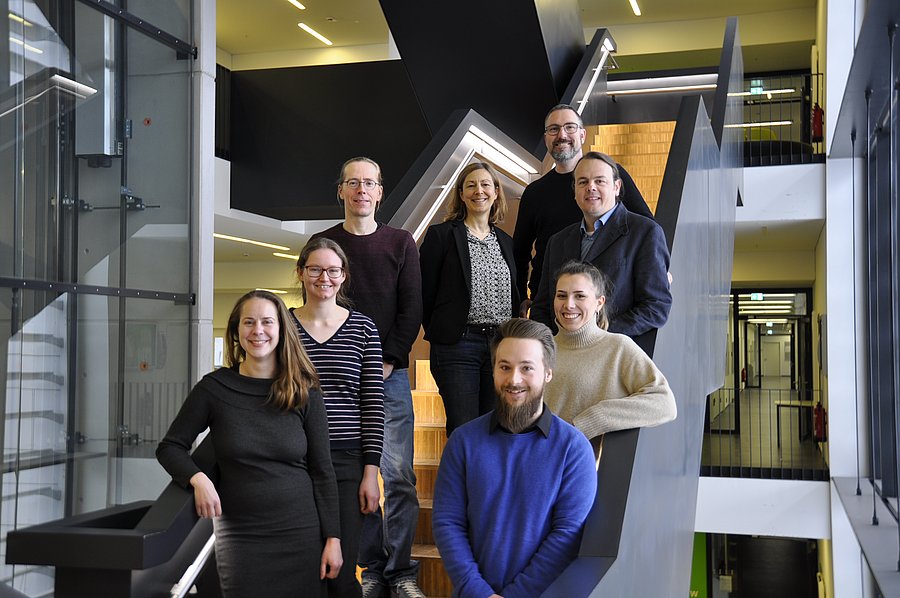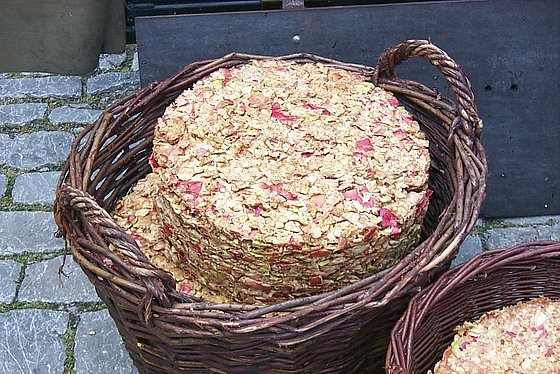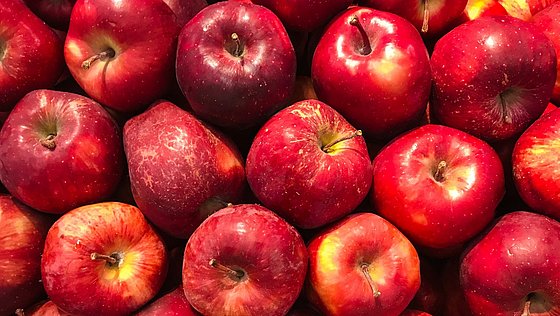
The apple project
From top to bottom:
Prof Dr Stefan F. Kirsch (Organic Chemistry), Prof Dr Nils Helge Schebb (Food Chemistry), Prof Dr Claudia Bohrmann-Linde (Didactics of Chemistry), Prof Dr Guillaume Delaittre (Organic Functional Molecules), Michelle Wiebel (Food Chemistry), Kathrin Bensberg (Organic Chemistry), Dr Rebecca Grandrath (Didactics of Chemistry) and Till Jessewitsch (Organic Functional Molecules)
Photo: UniService Transfer
The apple project
Interdisciplinary cooperation at the University of Wuppertal focusses on the sustainable processing of apple pomace
An interview with Prof Dr Claudia Bohrmann-Linde, Prof Dr Guillaume Delaittre, Prof Dr Stefan F. Kirsch and Prof Dr Nils Helge Schebb.
The project entitled "Chemistry of and with Food Loss from Apples" is an intra-university co-operation project involving the Didactics of Chemistry, Food Chemistry and Organic (Polymer) Chemistry. The common goal is to reduce food loss by synthesising active ingredients from apple pomace or selective components, which also involves the development of analytical standards and the investigation of biocompatibility.
The apple is by far the Germans' favourite fruit. Can this also be expressed in figures?
Claudia Bohrmann-Linde (Didactics of Chemistry): According to Statista, Germans consumed 22.4 kg of apples per capita in 2021/2022. That's almost twice as much as the consumption of bananas, which are the Germans' second favourite fruit. In addition, 630 million litres of apple juice were produced in Germany in 2022. In terms of apple varieties, the Elstar variety is the most popular apple variety in Germany with a share of almost 19 per cent. Incidentally, it emerged from the Golden Delicious and is now the most widely cultivated variety in Germany.
Apples are packed with minerals and vitamins. They say: "An apple a day keeps the doctor away". What role do apples play in your diet?
Nils Helge Schebb (Food Chemistry): In fact, a number of epidemiological studies show that fruit and vegetables are really healthy. The German Nutrition Society therefore recommends eating 5 portions a day. My family therefore eats a lot of fruit and vegetables every day and we are happy to be able to buy such good apples here in Wuppertal, including those grown locally.
However, you shouldn't overdo it with the nice sayings about nutrition. With a "good" diet, we can statistically add perhaps 3-4 years to our lives in good health, but not prevent illness and death. That's why we should above all enjoy life - and therefore also delicious food and dishes.
In industry, the processing of apples produces enormous amounts of waste. These apple residues are disposed of as waste. This is quite irresponsible in the context of the sustainability debate, as these leftovers could be recycled. A working group has been set up at the University of Wuppertal to look into the sensible utilisation of apple waste, known as apple pomace. Which scientists from which disciplines are involved and how did this collaboration come about?
Stefan F. Kirsch (Organic Chemistry): In view of the fact that millions of people worldwide are suffering from hunger, any kind of food waste is problematic. However, it is not only the food itself that is lost, but also the numerous resources used to produce it that have ultimately been invested for nothing. Agricultural land was also used to produce food waste in the first place; water, fertilisers and other technologies that pollute the environment and climate were used. Against this background, the sensible utilisation of all food waste is part of a global strategy for more sustainability, in which the apple pomace mentioned is only a small cog, but one that can be quite significant throughout Germany and regionally in the Bergisches Land.
We start by looking at the waste from the apple industry through the lens of chemistry. Which chemical compounds that nature has left us in the apple waste are actually present? Can we utilise these compounds? Perhaps as fine chemicals beyond classic petrochemistry? Or as building blocks for active ingredients or new materials? And can we use skilful experiments to get the younger generation to develop a feel for the value of food waste at an early age at school? All these questions require a broad team of chemical didacticians, food chemists, organic chemists and polymer chemists. I am very pleased that we have found such a great team, currently consisting of eight people, who are tackling this important research question together with confidence and enthusiasm. Claudia, Guillaume, Nils and I all agree that we have exactly the right research environment at the University of Wuppertal to achieve a great deal in the future. And perhaps this will develop into a topic that will also generate interest beyond chemistry.

Apple pomace
Photo: CC BY 2.0. jpg public domain
Every year, 70 million tonnes of apples are harvested worldwide and 250,000 tonnes of apple pomace are produced in Germany alone. Apple pomace contains a variety of valuable components. What are they, for example?
Bohrmann-Linde: As apple pomace is the pressing residue from juice production, many ingredients from the peel and seeds are also found in the pomace. In particular, there are various carbohydrates such as cellulose and hemicellulose, but also lignins, starch and pectins, the latter having gelling properties. Then there are other substances such as the antioxidant flavonoids and various triterpenoids such as betulinic acid, oleanolic acid and ursolic acid, which are interesting for further syntheses.
In contrast to household food waste, industrial food waste is easier to recycle. Why is that?
Guillaume Delaittre (Organic functional molecules): First of all, it is interesting to note that the Food and Agriculture Organisation of the United Nations distinguishes between food loss and food waste depending on the stage at which food is removed from the classic route, i.e. from the place of production (e.g. farm) to the consumer's digestive tract. If this happens before it reaches the grocery store or restaurant, it is referred to asfood loss. If this happens afterwards, it is referred to asfood waste. To facilitate recycling, the unconsumed food mass should be reproducible, not degraded in an uncontrolled manner and, if possible, already sorted out. Pre-consumer sources, such as those from the food processing industry, fulfil these requirements well and generally provide large quantities. Apple pomace, for example, is a residue from the pressing process in the production of juice, cider, wine, spirits, vinegar and jelly and accounts for around a third of the weight of the apple fruit. For some uses, food losses are perfectly fine, e.g. in processes where they are carbonised. However, for finer applications, where the main aim is to extract certain molecules in order to chemically analyse them, structurally modify them or create new materials, food loss is much more suitable.
Where and how can apple residues be utilised?
Kirsch: Currently, apple pomace is mainly used as high-fibre feed for livestock such as cows. All other applications - be it in beekeeping or hunting - are rather insignificant. It therefore makes perfect sense to utilise the ingredients of the apple pomace produced. Pectin as a gelling agent is an obvious choice and is already being successfully extracted from apple pomace using various methods. However, we are focussing on the utilisation of smaller, highly specific components such as triterpenoids, whose potential is not yet foreseeable.
It's hard to imagine, but apple residues can even be utilised for the fashion industry. Cactus, pineapple, mushroom and even apple leather products are becoming increasingly popular in times of sustainability. An Italian company in Bolzano is already leading the way. It uses a biodegradable plastic substitute based on milk protein in the production of apple leather, which is fully recyclable. Can such an example set a precedent?
Bohrmann-Linde: You can even make a very simple, but no longer stable, apple leather in chemistry lessons at school! There are lots of recipes for this, because this is more of a snack. For application products, apple pomace can be used to make robust apple leather that is mechanically resilient and flexible. It is one of the vegan leather variants and is used for some shoes or bags, among other things. During production, however, the biomass is usually mixed with a plastic, e.g. polyurethane, as a binding agent and the whole thing is then applied to a cotton base. Polyurethane is familiar from foam mattresses or construction foam. It is not biodegradable and adds to the mountain of plastic waste. The variant with milk protein mentioned in the question is being developed with the intention of actually obtaining a biodegradable vegan leather. However, this type of apple leather is still in the development stage. With biodegradable plastics, it is important to ensure that they remain stable over the long term during use and do not degrade prematurely due to external influences.
The pomace can even be used as fuel. A team from the TU Bergakademie Freiberg has presented an optimised process with which ethanol with an alcohol content of up to six percent can be produced. Is this perhaps also a future source of biofuel?
Schebb: Utilising side streams from the (food) industry to produce valuable synthesis precursors - as in our project - but also using them as a source of fuels is very promising. The current practice of producing "sustainable" fuels or the biological material for biogas plants from plants that are grown in competition with food-producing plants seems problematic to me with regard to the food supply for the growing world population.
You say that you want to utilise your complementary expertise in this working group. What are these?
Delaittre: As university teachers, one of our main tasks is to contribute to the goals of state organisations through education, with one of the most important current goals being the establishment of a sustainable society. We are lucky to have a strong chemistry education section in Wuppertal, which is led by Claudia. In this case, she uses apple pomace as a biological model source to develop school programmes that help raise awareness among younger generations about the issues of food loss and waste, while changing the way we think about chemical production. At the same time, we are researchers and are motivated by new discoveries. Here, as Stefan emphasised, we are mainly interested in triterpenoids, which are found in apple pomace in certain quantities. As some of them are already known for their therapeutic properties, his team is looking at their structural modification to possibly develop even more active derivatives. In my own group, we are interested in using these molecules to produce novel polymers that may have unique properties. This is also a way to partially reduce the dependence on petroleum-based chemicals to produce materials. However, before we can do all this, these triterpenoids need to be efficiently extracted from the raw apple pomace and characterised. This is where the expertise of Nils and his team comes into play.

Apples
Photo: Matheus Cenali public domain
Sustainable chemistry is becoming increasingly important for people and the environment. Can apples play a decisive role in this?
Kirsch: This question is not easy to answer, as it would be like looking into a crystal ball. Truly sustainable chemistry, which sets itself apart from the petrochemical pathways, can only be achieved through a multitude of small adjustments that have to mesh perfectly. And this is where the apple can really play a role: Not the decisive role, but one that helps to shape our future better.
Uwe Blass
Prof Dr Claudia Bohrmann-Linde, Didactics of Chemistry
Prof Dr Guillaume Delaittre, Organic Functional Molecules
Prof Dr Stefan F. Kirsch, Organic Chemistry
Prof Dr Nils Helge Schebb, Food Chemistry
